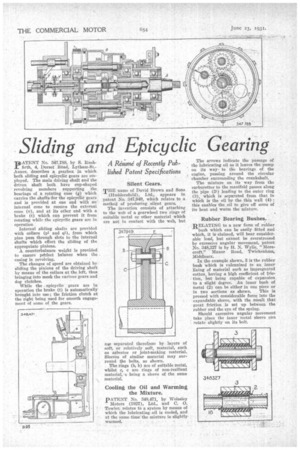Sliding and Ep icyclic Gearing A Reston . of Recently Publisherl Patent Specifications
Page 60

If you've noticed an error in this article please click here to report it so we can fix it.
Th.ATENT No. 347,788, by S. Rush firth, 4, Dorset' Road, Lytham-St.Annes, describes a gearbox in which both sliding and epicyclic gears are employed. The main driving shaft and the driven shaft both have cup-shaped revolving members supporting the bearings of a rotating case (g) which carries the shafts for the epicycliC gears and is provided at one end with an internal cone to receive the external cone (v), and at its other end with a brake (t) which can prevent it from rotating while the epicyclic gears are in operation.
Internal sliding shafts are provided with collars (pl and ql), from which pins pass through slots to the internal shafts which effect the sliding of the appropriate pinions.
A counterbalance weight is provided to ensure perfect balance when the . casing is revolving.
The changes of speed are obtained by sliding the pinions of the driving shaft by means of the collars at the left, thus bringing into mesh the various gears and dog clutches.
While the epicyclic gears are in operation the brake (t) is automatically brought into use; the friction clutch at the right being used for smooth engagement of some of the gears.
Silent Gears.
THE name of David Brown and Sons " (Huddersfield), Ltd., appears in patent No. 347,1-349, which relates to a method of producing silent gears.
The invention consists of attaching to the web of a gearwheel two rings of suitable metal or other material which are not in contact with the web, but ag,e separated therefrom by layers of soft, or relatively soft, material, such as asbestos or joint-making material. Sleeves of similar material may surround the bolts, as shown.
The rings (b, b) are of suitable metal, whilst c, c are rings of non-resilient material, 0 being a sleeve of the same material.
Cooling the Oil and Warming the Mixture, pATENT No. 348,471, by Wolseley Motors (1927), Ltd., and C. 0. Towler, relates to a system by means of which the lubricating oil is cooled, and at the same time the mixture is slightly, ; warmed.
The arrows indicate the passage of the lubricating oil as it leaves the pump on its yakto the bearings of the engine, passing around the circular chamber surrounding the crankshaft.
The mixture on its way from the carburetter to the manifold passes along the Pipe (39 leading to the outer ring (3), which is separated from that in which is the oil by the thin wall (4) ; this enables the to give off some of its heat and warm the mixture.
Rubber Bearing Bushes.
RELATING to a new form of rubber bush which can be easily fitted and which, it is claimed, will bear considerable load, but cannot be overstressed by excessive angular movement, patent No. 348,327 is by It. N. Wylie, "Morecroft," Manor Road, Twickenham, Middlesex.
In the example shown, 3 it the rubber bush which is vulcanized to an inner lining of material such as impregnated cotton, having a high coefficient of friction, bet being capable of expansion to a slight degree. An inner bush of metal (2) can be either in one piece or
in two sections as shown. This is pressed with considerable force into the .expandable sleeve, . with the result that great friction, is set up between the rubber and the eye of the spring.
Should excessive angular movement . take place the inner -metal sleeve can rotate slightly on its bolt.




























































































